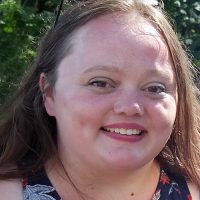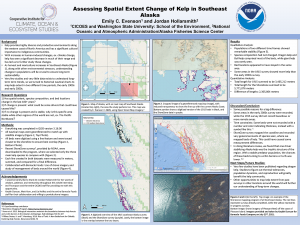
Emily Evenson
Washington State University
Research Mentor: Jordan Hollarsmith
Project: Assessing Spatial Extent Change of Kelp in Southeast Alaska
My name is Emily Evenson, and I am a senior majoring in Wildlife Ecology and Conservation Sciences with minors in Forestry and Geospatial Analysis at Washington State University in Pullman, Washington. This summer, I had the pleasure of working with Dr. Jordan Hollarsmith of the Alaska Fisheries Science Center for a remote internship investigating spatial extent change of kelp beds in Southeast Alaska in the last century.
Kelp ecosystems provide highly diverse and productive habitats and have significant cultural importance to many indigenous communities of Alaska. With an increase in human-induced changes nearshore, populations have seen a substantial decrease among much of their range of the western coast of North America. As harvest and mariculture increase in popularity, understanding population changes will be crucial to ensure long-term sustainability in an everchanging and warming world. In Alaska, very few studies and very little data exists to understand long-term trends in populations, so we turned to the state’s massive collection of historical nautical charts to understand changes in extent in two different time frames: the early 1900s and the early 2000s. These early 1900 nautical charts were created because the U.S. needed a critical ingredient in fertilizer: potash salts. During this time, Germany was the only country in the world mining potash, and the U.S. very quickly realized they needed to find a local source. With knowledge of indigenous communities using kelp as fertilizer, the U.S. Department of Agriculture commissioned surveys to survey these beds in the Pacific Northwest and Alaska.
This summer, most of my work was completed in QGIS, an open-sourced geographic information systems software. I was tasked with georeferencing the nautical charts and digitized around 1500 beds in S.E. Alaska and some parts of western Alaska. Each bed had a corresponding bed number and other data like species composition, estimated tonnage, estimated area, and estimated thickness. The 1900 survey was compared with a modern survey called ShoreZone, which gives a general account of kelp species seen. I downloaded the vector geometry (lines) associated with the survey, brought that into QGIS, and made an overall comparison by summing the two surveys’ lines. Results indicated over a 2.3-million-meter difference in the two surveys, something that we will be looking into more and why that is.
One important part of this project my mentor and I wanted to establish was collaboration. During the summer, Jordan and I worked with Barnacle Foods: a Juneau, AK-based food company that prides itself in sustainable harvest and ensures the overall health of the kelp ecosystem and the health of their communities around S.E. Alaska. Owners Matt and Lia, along with their research intern Kaylah, started a drone mapping the beds they harvest, which they graciously shared with us. Future collaboration is planned where they will be looking into management practices of kelp around the world and in general.
Overall, I thoroughly enjoyed this experience. I learned so much about these vital ecosystems and was very grateful to have a mentor like Jordan to answer any questions I had and provide guidance when needed. The CICOES virtual seminars, intern socials, and the end of the week conference were incredible experiences that I will never forget. I am grateful to CICOES for creating this internship for students to gain research experience in an important field.

